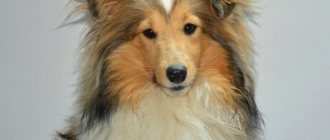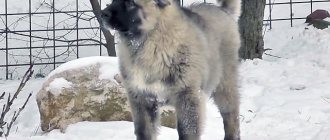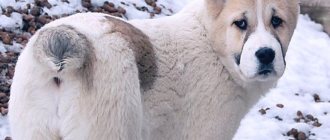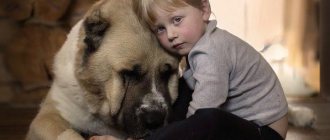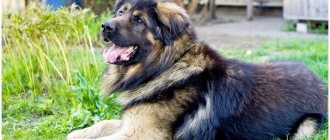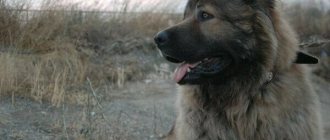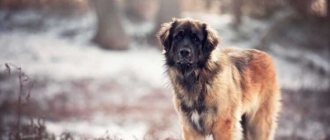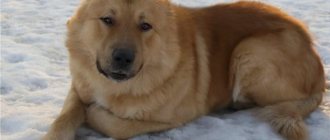In the modern world there are a large number of dog breeds for every taste. Some people like big dogs, while others like miniature pets.
Small breeds are suitable for keeping in an apartment, but if you need a protector and a loyal friend, it is better to pay attention to large breeds.
One of the ancient breeds is the Caucasian Shepherd Dog or Wolfhound. This breed appeared in the Caucasus more than two thousand years ago.
Description of the Caucasian Shepherd breed
Popularity 218th place among 263 dog breeds
Lifespan:
10-11 years
Breed group:
Sentinels
Height:
males: 68-75 cm, females: 64-71 cm
Country of origin:
Russia
Average price:
25-35 thousand rubles
Weight:
males: 50-75 kg, females: 45-70 kg
Latest articles Cat health
Rabies vaccination for cats: choice of vaccine, necessity, schedule 01/22/2022 4 0 0
Selection and adaptation
TOP 20 best cat breeds for families with children 01/22/2022 25 0 0
Breed characteristics
| Short description | |
| Origin: | Caucasus |
| Conditions of detention: | In a separate enclosure/in the courtyard of a private house |
| Purpose: | Herd (herding)/guard |
| Color: | Grey, red, white, brindle, piebald, fawn, spotted, light and reddish shades are allowed |
| Wool length: | Long (10-12 cm) or short (6-7 cm) depending on the variety |
| Adult dog size: | Male: height (withers) – from 68 cm, weight – from 50 kg. Bitches: height (withers) – from 62 cm, weight – from 45 kg. |
| Average life expectancy: | 10 – 12 years |
| Walk: | Required twice a day, minimum duration of at least an hour, preferably free movement throughout the habitat |
| Physical activity needs: | Requires long-term, moderate-intensity daily exercise |
| Fédération Cynologique Internationale (FIC) classification: | Recognized by the FCI in 1990 Group 2/Section 2. Molossians (2.2. Mountain dogs) |
| Puppy price: | From 30 to 50 thousand rubles. |
Advantages and disadvantages
- Pros:
- an excellent security guard who can live outside all year round;
- can get along in an apartment with sufficient walking;
- balanced nervous system and calmness;
- ease of training and socialization;
- unpretentious in care and feeding.
- Minuses:
- requires a strong-willed character from the owner;
- sometimes guards the owners’ home too carefully;
- needs walks if he does not have a spacious enclosure.
Caring for the “Caucasian”
Not complicated. It is enough to comb out dead hair 1-2 times a week. When shedding, you can bathe it, then the undercoat will come off faster. Large, fast-growing claws should be trimmed every 10 days.
A great watchman and security guard should have clean ears! – Waxy sulfur deposits are removed every 2-3 weeks.
Watch your nutrition! No more than 1.5 standard rations per day. Violation of this rule leads to obesity and the appearance of various skin diseases, including eczema.
Scratching after bites of various skin parasites (lice, fleas, etc.) can also lead to eczema.
An adult Caucasian Shepherd will be absolutely happy if she is given the opportunity to do what she was born to do - guard, protect and attack. Otherwise, why did nature endow it with jaw strength with a pressure of 250 kg per 1 square meter? cm?!
Key facts
The Caucasian's country of origin is Russia. An image of this species is found on some coats of arms of Georgian princes. The modern description of the Caucasian Shepherd breed says that in Russia a large number of breeding nurseries are engaged in professional breeding.
If you want to make such a friend, you need to consider some points. For example, Caucasians perceive only members of the family in which they live. They treat all other people quite unkindly. The animal instantly reacts to any potential danger, so when walking it, you always need to be on alert. The characteristics of the Caucasian Shepherd dog breed emphasize that the dog needs strict education under the guidance of a strong-willed owner.
You should refuse the purchase if you have never dealt with large dogs before, and also if you cannot visit training grounds with your dog.
Representatives of this type are fully formed by the age of two, both physically and mentally. This fact should definitely be taken into account when taking a course with a dog handler. This species is highly trainable and has excellent working qualities. In a fit of anger, it is almost impossible to restrain a dog; at these moments they become angrier than pit bulls and Staffords, which is very dangerous, given the size of the dog.
Caucasians belong to the category of giants. Weight ranges from 45-50 kg for females, from 50 to 60 kg for males. Dimensions of the Caucasian Shepherd at the withers: up to 70 cm for females, up to 74 cm for males. The average life expectancy of a Caucasian Shepherd is 15 years, and long-livers are common.
Vaccinations and susceptibility to disease
Preventive vaccinations against rabies and other deadly infections are carried out annually after the dog reaches the age of 12 months. The first vaccination for a Caucasian Shepherd puppy is given against distemper and enteritis at 4 weeks. Then at 8 weeks this vaccination is repeated and the baby is additionally vaccinated against leptospirosis and hepatitis. Then at 12 weeks the dog is vaccinated against rabies.
On a note. Deworming is always necessary 7-14 days before vaccination.
Caucasian Shepherds are a hardy dog breed that often does not have health problems and has good immunity.
Common "breed" diseases:
- hip dysplasia;
- various diseases of the musculoskeletal system;
- disruption of the endocrine system;
- eye diseases;
- diseases of the cardiovascular system.
Caring for puppies
For the full development of Caucasian Shepherd puppies, it is necessary to take a responsible approach to feeding. Usually puppies up to 1 month and a little older feed on their mother’s milk, and at the age of 1.5–2 months they are already going to live in a new home. After reaching this age, all foods from the diet of an adult dog must be gradually introduced into the food of babies.
For young individuals, diet is important. So, a puppy 2 months and younger should eat 5-6 times a day, at 3 months - 4 times, at 4-6 months - 3 times, from 7 months to 2.5-3 years, shepherd puppies should eat twice a day. day.
It is important. As the puppy grows, the portion size should increase and the frequency of feedings should decrease.
Rules for caring for a Caucasian Shepherd puppy from the moment it arrives in the house:
- to prevent the development of rickets and weakening of the limbs, it is necessary to provide the baby with sufficient space for play and movement;
- tethering a Caucasian Shepherd puppy is strictly prohibited;
- to avoid falling and injury, children should not be allowed to carry the baby in their arms;
- You can only walk a Caucasian Shepherd puppy on a leash, but in deserted places you can let your pet out for a short time;
- puppies can only go for walks after they have received the necessary vaccinations;
- You should not play tug-of-war with small Caucasian wolfhounds: this can lead to the formation of an incorrect bite.
This is interesting. Small Caucasian Shepherd Dogs, unlike their adult relatives, try to avoid situations that threaten them. This is how they show a sense of self-preservation, not cowardice. The owner should not allow his little pet to get into hopeless situations. Otherwise, the puppy will become embittered.
History of the origin of the Caucasian Shepherd
There is no consensus on when and from which ancestors this subspecies was obtained. Most scientists have come to the conclusion that the closest relative of the Caucasian Shepherd is the Tibetan Mastiff or Tibetan Great Dane. Russia is considered the country of origin.
According to another version, animals first appeared in the ancient state of Urartu, located in the Caucasus. Images were discovered that vaguely resembled these watchdogs.
Interesting Facts:
- The first chronicle mention of this breed dates back to 1121 BC, when the emperor of the Zhou dynasty received a puppy as a gift;
- in 1765, an official order was issued in Russia, which obliges the owners of Caucasians to involve them in guard and security service;
- in the 19th century they tried to use this species for search purposes, but the experiment failed, and German and East European shepherds replaced Caucasians;
- Animals are often given intimidating nicknames, which is facilitated by their menacing appearance.
Owning a Caucasian watchman is a big responsibility, since a dog that is not raised correctly can be aggressive and dangerous.
Caucasian wolfhound crossbreeds
Mixing of any large breed with the Caucasian Shepherd is allowed. The most popular are crosses with German shepherds, huskies, St. Bernards, and huskies.
The most popular type of Caucasian Shepherd crossbreed is the Alabai. This mixture takes the best character traits from its parents and becomes excellent guards, who have practically no equal among their relatives.
Appearance of the Caucasian Shepherd
General impressions
In addition to the single standard described by the Russian Cynological Federation, there are several subtypes that have slight visual and behavioral differences among themselves:
- Georgian - these dogs are stronger and more massive, the body length is several centimeters longer than other species, the coat is long, of the same shade, most often zone-gray;
- Armenian - are the smallest individuals,
- mountain Azerbaijani and steppe Azerbaijani;
- Dagestan - resembles Georgian, but has a bicolor or tricolor color.
The first standard was registered in 1931. It is based on the Georgian type of animals.
It is interesting that for two years in a row, in 1970-1971, the title of World Champion at the International Exhibition was awarded to Caucasians. The photo of the Caucasian Shepherd shows that in front of you is a representative of a giant breed.
Head
The head with a square forehead is massive. The cheekbones are well developed and have clear outlines. The muzzle is large, blunt in shape. Convex forehead with a shallow groove. The lips are thick and close tightly. The color of the nose is black, for light colors brown is acceptable. The ears are not large and stop within a few days after birth. It is worth remembering that if you plan to attend foreign exhibitions with your dog, it is better not to crop the ears, since according to the new international rules this operation is prohibited. The eyes are deep-set, dark in color, the eyelids fit tightly to the eyeball. The bite is standard, scissor-shaped. Number of teeth – 42 pieces.
Neck
The neck of dogs of this breed is powerful, muscular, and strong. The scruff is clearly defined. Significantly shorter than the length of the skull bones. The angle relative to the dorsal line is 30-40 degrees. A slight “suspension” is acceptable, but practice shows that such dogs rarely receive prizes at exhibitions.
Torso
The sternum is wide, low-set, round in shape. The lowest point of the chest should be at the level of the dog's elbows. The belly is lean. The withers protrude significantly above the line of the back and are wide. The back is straight, level, the croup is slightly sloping. The back muscles are strong and wide. The loin is shortened in males, a slight lengthening in females is acceptable.
Forelegs
The paws are powerful, the pasterns are strong, stable, and short. When examining the forelimbs from the front, you can see that the paws are widely spaced, straight, parallel to each other. Elbows are pulled back, and deviation to the side is considered a violation of the standard.
Hind limbs
The hind limbs are parallel to each other. The hock joints are slightly straightened. When the dog is standing, the feet are brought out under the hock joint, forming a 90-degree angle. Pulling back the hind legs is unacceptable.
Tail
The tail is set high, sickle or ring shaped, relaxed when calm. The tip of the tail reaches the hock joint.
Movements
The movements are not constrained, the main gaits are slow - a walk or a wide slow trot. With active movements, a heavy gallop without signs of instability is acceptable. The front legs do not cross the midline when running. The tops of the croup and withers should be at the same level. During active movements, the dog does not rake the soil with its paws and does not deviate from the straight path of movement. The elbow joints do not turn outward when moving. The paws should spring slightly when pushing.
Wool
The coat of this breed is thick and thick. This is due to the fact that the Caucasian Shepherd Dog at one time adapted to the climatic conditions of the mountainous regions of the Caucasus. Three-layer wool:
- the top layer retains moisture from the outside;
- spinous layer,
- the undercoat stores heat under the fur
Based on which of the three layers predominates, there are short-haired types, long-haired types and intermediate ones.
Color
Acceptable colors of the Caucasian Shepherd according to the FCI breed standard: any solid solid color, any spotted color. It is unacceptable if the Caucasian Shepherd is uniformly black, brick brown, genetically blue, or unexpressed black. The most common colors are red, grey, brindle and white. The dog's eyelids and lips should have a bright black continuous outline.
Size
The height of a Caucasian Shepherd Dog at the withers should be at least 68 cm and not exceed 75 cm for males. The optimal height is 70-72 cm. The female should not be lower than 64 cm, but also not exceed the limit of 70 cm. The weight of a Caucasian shepherd dog should not fall below 50 kg, and a female shepherd dog should not fall below 45 kg.
Any deviation from the official breed standard may reduce the show score. Disqualifying defects do not give the dog the right to participate in national and foreign exhibitions.
Distinctive features
The Caucasian Shepherd Dog is recognized by the FCI and is included in group 2/section 2. Molossians (2.2. Mountain dogs). Large dogs with a powerful, muscular croup are perfectly adapted to the climatic conditions of the region. They are ideal assistants to shepherds on pastures and are famous for their unsurpassed guard qualities.
Basic exterior data:
- The head is massive, heavy, wedge-shaped.
- The skull is wide, the frontal part is flat, there is a fold.
- The ears are hanging, short, set above the eye line, triangular in shape, often cropped.
- The eyes are small, oval in shape, dark in color, most often brown.
- The eyelids are dry and black.
- The cheekbones are large.
- The stop is not pronounced, the transition is smooth.
- The muzzle is shorter than the forehead, not pointed.
- The nose is wide. The nose is voluminous and black; in light-colored dogs it can be brown.
- The lips are thick, dry, and fit tightly.
- bite . The jaws are strong. The teeth are white, very large, strong, a complete set of 42 teeth - 22 on the lower jaw and 20 on the upper jaw.
- The croup creates an almost horizontal line, wide and muscular.
- The bones are large.
- The skin is thick and elastic.
- The neck is short, wide, powerful.
- The chest is wide.
- The withers are well visualized and wide.
- The back is clearly muscled, straight and wide.
- The loin is slightly convex.
- Limbs straight, parallel; The hind limbs have significant fur.
- The hock joints are strong and wide.
- The paws are compressed, massive, oval in shape.
- The gait is a slow trot.
- The tail is long, set high, and completely covered with hair. In its natural state - in the form of a sickle, hook or ring. Cupping is allowed.
- Color: gray, red, white, brindle, piebald, fawn, spotted, light and reddish shades are allowed.
- The coat is straight, thick, coarse, with a light-colored undercoat; The length of the coat is 6-7 cm for short-haired dogs and 10-12 cm for long-haired dogs, slightly shorter on the head and limbs, and fits tightly to parts of the body.
Personality of the Caucasian Shepherd
Who is the Caucasian Shepherd Dog suitable for? The breed has a very difficult character. That is why it is not recommended to get one for people who do not have experience with large breeds. Caucasian Shepherds are distinguished by their persistence, stubbornness, and fearlessness.
Dogs have excellent watchdog qualities. They are unpretentious in maintenance, preferring outdoor enclosures to apartment keeping or indoor living. In winter they do not freeze outside due to their thick undercoat.
The breed treats children quite well, but does not show active interest or sympathy. But if there is a child in the family where the Caucasian lives, perhaps he will become number one for the dog. These dogs are monogamous by nature and recognize only one owner, perceiving the rest of the family as their pack.
How does the character of a Caucasian Shepherd dog differ in age from the behavior of a puppy? Kids are more willing to make contact and are more attached to a person; as the dog grows older, it shows more and more independence and isolation.
The Caucasian Shepherd is good with other pets. The main condition is that the other dog must belong to the category of small or medium breeds. A Caucasian will dominate any large dog in every possible way, which can lead to fights and serious injuries to both. If you have such a dog, be prepared to walk it away from places where dog walkers congregate.
This breed must be socialized. It is recommended to start training and training before six months. The optimal time is to start walking after the quarantine ends after the third vaccination. Since this breed is quite stubborn, self-sufficient and independent, training an adult dog will be a rather difficult process.
Physical punishment instantly causes attacks of aggression in this breed.
At home, the dog behaves calmly and is not particularly active. The dog is quite friendly towards strangers in the owner's house, although he is wary. The dogs are noticeably aloof and do not require constant attention, but are incredibly loyal to their family members.
Character and behavior
By nature, Caucasian Shepherds are balanced, fearless, decisive, self-confident and slightly stubborn dogs. They are endlessly loyal to their owners. Caucasians show love and affection to the rest of their household.
They have well-developed security qualities, so they treat all strangers with distrust and hostility, greeting them with loud barking. In addition, representatives of the breed have an amazing feature - they are able to accurately determine whether the owner and his family are in danger.
If threatened, such a dog will immediately defend its owner and will fight with any, even the most powerful, opponent, until the last drop of blood.
Caucasian Shepherds get along well with other pets, but only if they grew up with them. They will not offend smaller pets, but they will most likely conflict with their larger counterparts, seeking dominance over them.
Attitude towards children
Caucasian Shepherds treat their owner’s children very well and try to protect them from all sorts of dangers. They willingly participate in all children's games. But children should not be left alone with the dog - due to the dog’s enormous height and strength, it can accidentally harm the child.
Education and training
The incredible groundless aggression that is often attributed to this breed is a myth. It can only arise as a result of improper upbringing or handling of the animal. Control of the dog's behavior begins a few days after the baby arrives at the new home. Teaching the exercises is done calmly and methodically, with multiple daily repetitions.
By the end of the first year of life, the dog should understand and be able to carry out a number of commands:
- “no/fu” – the command ensures not only the safety of passers-by, but also the pet itself, for example, in a situation when she decides to eat something from the ground or a stranger tries to treat her while out for a walk;
- “sit/lie down” are the first commands that a puppy learns;
- “nearby” is another command that ensures safety
- “teeth” – if an exhibition career is planned, this team is one of the first to learn;
- “to place” - usually this command is used to send the dog to its place in case of misconduct;
- “to me” - in any situation the animal must hear it and immediately carry it out.
Toilet training for a new family member also begins as early as possible. Regardless of the season - winter, spring, summer or autumn - the owner must take the baby for a walk every day at a certain time.
If the puppy shows interest in shoes and chews furniture, it is necessary to strictly but calmly prohibit him from doing this. Physical punishment is unacceptable.
It is recommended that you take your dog through OKD - a general training course, during which competent dog handlers will tell dog owners how to raise Caucasians and how to find an approach to the dog, taking into account its breed characteristics. It is worth remembering that giants and molossians are considered “late-maturing breeds”, that is, the dog’s full formation ends by two years, and before that it is a teenager.
This breed is not suitable for various activities, such as agility (passing a course with obstacles), freestyle (dancing a person with a dog), frisbee (throwing a ball, plate or puller).
Many large breeds, due to their size, try to check on their owner once in a while. Any attempts at dominance or aggression must be calmly and methodically suppressed. A properly raised dog will never offend family members.
In addition to OKD, you can take your dog through a training course for protective guard service. In any case, it is desirable that the upbringing and training of the Caucasian Shepherd take place under the supervision of a trainer.
Key points in training
The stubborn, self-sufficient nature of the Caucasian Shepherd dictates the peculiarities of its training. The main qualities that a dog owner must have are willpower, perseverance, inflexibility and strong character. The dog obeys only unconditional authority and leader.
Training a Caucasian Shepherd should begin from the moment it appears in the house. Key points of training:
- establish rules of behavior and clear prohibitions;
- do not use physical force;
- do not raise your voice;
- do not rush the dog in the process of teaching commands;
- take a course of OKD and subsequently CS;
- accustom to a muzzle.
In the absence of experience, it is not recommended to train yourself. Caucasian Shepherds are intelligent and have a high level of intelligence. Learning and consolidation of skills occurs quite quickly. Therefore, an inexperienced owner may unknowingly “teach” the dog unwanted behavior.
It must be remembered that the most important period in the development of the psyche and physiology of an animal is the age of up to 9 months. The pet must complete basic training courses at this stage. Correcting mistakes made in raising a puppy is often beyond the power of even experienced dog handlers.
Read about how to properly train a dog in the article: “Training a puppy: effective methods from dog handlers, learning commands at home.”
Health and diseases of the Caucasian Shepherd
Possible diseases
In order for your pet to get sick as little as possible, you need to carefully monitor its health and regularly perform hygiene procedures.
The maximum harm to the health of Caucasian Shepherds can be caused by infectious diseases, which dogs tolerate quite seriously. In addition, the breed is susceptible to damage to certain systems and organs, as a result of which the following may develop:
- metabolic disorders;
- diseases of the musculoskeletal system;
- disorders of the central nervous system.
The most dangerous infectious diseases are plague, rabies, leptospirosis, and nonspecific tuberculosis. They can be suspected if the dog is diagnosed with the following symptoms:
- fever, temperature stays at 40 degrees, nose is dry and hot;
- drowsiness, apathy, complete lack of physical and emotional activity;
- during a walk, the dog does not want to go anywhere, the tail is down;
- the animal often asks to go to the toilet, frequent profuse vomiting;
- convulsions;
- copious discharge from the nose and eyes;
- The coat is dull and does not shine.
Many infectious diseases are prevented by vaccinations. Without them, it is simply dangerous to take the animal outside.
Among the diseases associated with metabolic disorders, Caucasian Shepherd dogs are characterized by obesity, cryptorchidism, fetal gigantism during intrauterine development, and dwarfism. Obesity is treated by selecting a special diet, and other diseases by hormonal therapy.
Disorders in the development of the musculoskeletal system include hip dysplasia (the scourge of modern dog breeding), weak pasterns, club feet, congenital lameness, mainly in the hind legs.
Epileptic seizures, muscle cramps, neuroses and behavioral disorders are characteristic of dogs with congenital or acquired diseases of the central nervous system.
Food allergies are not common in this breed, but you should be wary of new foods in the diet and chicken meat. If you notice scratching on your dog's skin after changes in diet, it is recommended to return to the usual feeding pattern. In severe cases, allergic swelling of the muzzle and larynx may develop.
Reproductive health
Dogs over one year old are allowed for breeding. A female dog comes into heat twice a year. Its duration is on average 24-28 days. With this cycle, mating occurs on days 11-13. Males can be used for breeding no more than 8 times a year.
Provided a healthy pregnancy lasts 56-66 days, childbirth is easy and without complications. The bitch can cope on her own, there is no need to resort to the help of a veterinarian. There are usually 4-8 puppies in a litter. Caucasian Shepherds have excellent maternal instincts, which guarantees the health and safety of their offspring. If weak puppies are born, supplementary feeding with special nutritional mixtures is recommended.
If the dog is completely healthy, sterilization is not recommended. If there are medical indications (pyometra, cancer, frequent false pregnancies, mastopathy), the operation is performed no earlier than a month after the end of estrus or the cessation of feeding the puppies.
Mating
Puberty occurs slowly in large breeds.
- The first heat in a Caucasian Shepherd bitch is recorded at the age of 5-6 months , after the appearance of molars, sometimes accompanied by molting. It often goes unnoticed, so owners need to carefully monitor the dog’s behavior. The main sign of heat is aggression towards male dogs.
- It is recommended to note the dates of the first and subsequent heats in a separate notebook, since females are ready for mating after the third heat. This usually occurs towards the end of the dog's second year of life. It is not advisable to carry out mating earlier. This can negatively affect both the health of the dog itself and the health of its offspring.
- Sex hormones in Caucasian Shepherd dogs begin to be produced by 6 months. However, knitting them before 2 years is also not recommended.
- Mating takes place on the 10th day after the start of estrus and takes place in the male dog’s territory. When making a pair, it is necessary to observe the hierarchical principle and take into account the sign of dominance. This is especially important during the first mating. The rule is that the “experienced” partner should dominate the “inexperienced” one.
Given the aggressive nature of the Caucasian Shepherd, a muzzle is often put on the bitch when mating. In any case, the mating site should be deserted, the possibility of strangers appearing should be minimized.
Features of feeding and diet
Compared to other large breeds, Caucasian Shepherds eat a relatively small amount of food. For 1 kilogram of animal weight there are 30-35 grams of natural food or 10-15 grams of dry food per day, which is significantly less than the usual norm for giant breeds. Accelerated metabolism ensures that all nutrients and vitamins are obtained from food. Caucasian Shepherd Dogs are one of the few breeds that are able to digest cow's milk.
What to feed your dog - dry food or natural food? Based on the fact that a dog is a predator, preference should be given to natural feeding. The diet must include lean varieties of muscle meat, offal (liver, kidneys, heart), and fish. To improve digestion and fermentation, tripe must be present in the dog’s diet, which can be used to replace one full feeding.
You can give any fruits and vegetables, depending on the taste preferences of the shepherd dog. If you want to raise a dry dog, then the breeder will give you an answer to the question of what food to feed the puppy. He will tell you which food is best suited for this breed, how many times to feed a one-month-old puppy, how the diet changes as the dog ages, and whether it is possible to give sour milk.
To prevent the formation of tartar, you can give your dog large bones to chew on, which it will not be able to swallow. For example, cow knee joint, beef tail. If your dog lacks certain elements, you can give vitamin complexes prescribed by your veterinarian.
Intrabreed types of CR
Caucasian Shepherd dogs raised in different regions of the Caucasus differ in the type of constitution.
In Kabardino-Balkaria, the short-haired type of CO is still found, once obtained from matings of old Balkar Shepherd Dogs and Georgian Mountain Dogs. They were called Sarmatian Mastiffs and were highly valued for their watchdog qualities, self-confidence and absolute loyalty.
A significant number of strong and large dogs came to Iran and Turkey after Russian-Circassian clashes under the name of the Circassian mountain shepherd, where they mixed with local Turkish, Armenian and Georgian species.
In Turkey, they even bred their own separate version of the shepherd dogs of the Anatolian Plateau - the Anatolian Karabash (kangal) - the closest relative of the “Caucasian” and the Central Asian shepherd dog.
In Iran, the Caucasian Shepherd Dog again merges with the Central Asian one, forming a single transitional form, which has so far been little studied. This form concentrates the two largest branches of Tibetan Molossians - the Caucasian and Central Asian Shepherd Dogs.
Armenian dogs look smaller, have lighter bones, an elongated muzzle, a more compact body, but are not inferior to the “Georgians” in the beauty and length of the coat, which also has a uniform zonal gray, brown and dark fawn color - this is the first type of Gamprov - Caucasian Shepherd dogs bred in the Armenian Highlands. The second type is more bony and larger, and has short, smooth coat.
Caucasian Shepherd of Armenian type
Shepherd dogs of Azerbaijan are divided into 2 types:
- Mountain - close to Georgian, but smaller in size.
- Steppe is a strong and dry type of square format.
“Azerbaijanis” are characterized by fawn and red colors; spotted individuals with short hair are also found.
A large KO was bred in Dagestan, tall, athletic, with strong bones and a desirable head. However, its almost square format does not allow it to be called the standard of the Caucasian Shepherd Dog.
The coat and color are varied; there are dogs with long hair, medium-length hair and very short hair.
In 1930, the Georgian type was recognized as the standard for breeding - the largest Caucasian Shepherd of all available types, which compares favorably with the rest with a more massive skeleton with a slightly elongated body, large stature, and heavy weight.
The semi-long, straight, thick coat with a uniform (most often zone-gray or fawn) color also gives the Georgian type an external attractiveness. The expressiveness of the muzzle is emphasized by a dark mask.
Today Nagazi (as Georgians call their wolfhound) is no longer a standard, but it was he who laid the foundation for the factory cultivation of a magnificent breed - the Caucasian Shepherd Dog.
Along with the presence of intrabreed groups, there are also 7 narrow subgroups of CR. For example, such as Kurdish, Gorban, Kazbegi, etc.
It is difficult even for an experienced dog handler to immediately distinguish the type and subgroup of the shaggy giant, if he is not closely involved in this particular breed, but any of them knows that the North Caucasian Shepherd Dog (Salsk steppes, areas of the Rostov and Astrakhan regions, Stavropol and Krasnodar territories) in contrast to Transcaucasian, has a drier (but not light!) type of constitutional build with high legs, a shortened format index and a more elongated head shape.
Transcaucasia (the entire southern part of the Caucasus, located beyond the Greater Caucasus mountain range) continues to cultivate more squat, massive animals.
However, such a difference does not in any way affect the range of the main breed characteristics of the KO - enormous physical strength, supported by powerful muscles, excellent hearing, quick reaction, flexible mind, possessive attitude towards the owner and his property, which allows them to efficiently cope with the role of a shepherd and a watchman at the same time.
Care and maintenance
For Caucasian Shepherds, it is preferable to keep them in an enclosure with a booth. The bottom of the booth should be lined with hay or straw to retain heat. If the animal is kept in an apartment, its bed should be in a place where there is a view of the entrance doors, otherwise the dog will feel discomfort.
Regular grooming includes brushing, trimming nails, and wiping the area around the eyes.
Caucasian Shepherds have thick fur. To prevent it from getting tangled, it is necessary to comb it regularly. For long-haired representatives, especially during molting, it is better to use a furminator. Frequent washing is not recommended. It is necessary to bathe your dog as soon as it gets dirty. Show dogs undergo cutting and grooming procedures. Nails must be trimmed with a nail clipper at least once a month.
During the warm season, many representatives of this breed carry ear mites. Therefore, every day it is necessary to carefully examine your ears for increased secretion of earwax. If your dog constantly scratches his ears and rolls his head on the ground or floor, and there is a large volume of dark yellow discharge in his ears, you should contact a veterinarian.
Many owners are concerned about how to care for their pet's teeth. For prevention, you can use special products in the form of treats or special drops, which should be added to a bowl of water daily to cleanse the mouth of plaque and unpleasant odor.
The Caucasian Shepherd is a breed that has its ears cropped within a few days of birth. Usually the operation is performed on the fifth day. The ear cartilage does not require special care after the procedure, but it is necessary to keep an eye on the baby or litter to prevent injury. If you plan to attend foreign exhibitions with your dog and are expecting a puppy from a certain litter, it is worth discussing the issue of docking with the owner of the bitch in advance, since the introduction of docked animals into the ring has been prohibited in some countries since 2013.
The general rules for the care and maintenance of the Caucasian Shepherd are not very different from the requirements for other large breeds of dogs. The main thing is to carry out hygiene procedures in a timely manner and give room for movement.
Ear cropping
To maintain the historical image of the breed, puppies' ears are cropped. But today you can see Caucasian Shepherd dogs with undocked ears. The owner has the right to decide for himself whether to undergo this operation for the pet or not. In practice, breeders make decisions for him. After all, ears are usually cropped in puppies at the age of several days.
This is not just cosmetic surgery. Long ears interfere with the shepherd's work. In some countries such manipulations are prohibited. Pupils with cropped ears cannot participate in exhibitions on their territory.
Tips for choosing a puppy
Before purchasing a puppy, determine the purpose for which you are getting it. If you just want a big furry friend in the family, opt for a female dog, especially if you have children. Bitches learn easier and faster, they are more open and cheerful, and can become a good companion for a child.
If you want your dog to become an excellent guard, you should buy a male. It must be taken into account that they periodically test their master’s authority through disobedience and attempts at dominance.
Many potential owners are concerned about the question of how to choose a purebred representative of the breed. You need to purchase a puppy from a breeding nursery with a full package of documents - this is a puppy card, which is then exchanged for a pedigree in the Russian Canine Federation, a veterinary passport with vaccination marks. Some breeders fill out a purchase agreement.
By purchasing a dog from a professional breeder, you receive a guarantee that the animal is a purebred representative of this breed, and therefore fully complies with the standards. At the moment, many conscientious owners test their dogs for dysplasia, and if the parents of the litter in which you choose the dog have any, they will definitely show them to you.
When meeting your baby, observe how he behaves. Caucasian Shepherd puppies should be cheerful, active, play with littermates, touch them, growl and bite. The baby should actively make contact with new people, he should not run away and hide.
Upon visual examination there should be no umbilical or inguinal hernias, the bite is normally scissor-shaped, the dental formula is 6x6.
Before buying a baby, you need to consult an experienced specialist in the field of this breed, who will tell you in detail what points you need to pay attention to. You should not focus on cost - the high price of a dog does not guarantee full compliance with the standard.
How to choose a puppy
When choosing a Caucasian Shepherd puppy, the future owner needs to answer several questions:
- For what purpose is it intended to purchase a puppy of this particular breed ? If the main duties of the dog will include guarding the house or territory, it is necessary to choose a puppy from parents who have diplomas from CS courses at various levels. If you plan to participate in exhibitions, you should give preference to a litter of champions and prize-winners.
- The second point you need to decide is the gender of the puppy. If there are small children in the family, the choice should be made in favor of a female dog. They are calmer, have less pronounced aggressive qualities, and are easier to train. Males should be chosen by dog breeders with experience interacting with guard and guard breeds. An indispensable condition for an obedient dog that can be trained and controlled is a strong and powerful owner. Otherwise, the dog can pose a real threat to the inhabitants of the house and random passers-by on the street.
Regardless of the purpose of purchasing a puppy and choosing its gender, it is necessary to evaluate the psyche of the future guard. This can be done in the nursery, observing the parents. It is also worth paying attention to the dog’s attitude towards its owner, level of obedience, and reaction to strangers. The combination of these signs will help you make the right choice.
The Caucasian Shepherd Dog is the standard of fearlessness, courage and courage. Despite their impressive size and unfriendly appearance, dogs of this breed are able to provide delightful moments in communication with them. Their devotion to "family" makes them popular and desirable.
5 / 5 ( 1 voice )
Color and coat type
The breed standard does not impose any color requirements on Caucasian wolfhounds. Red and white, black and fawn dogs take part in the exhibitions; spotted and striped pets are also found. Long-haired shepherd dogs with coarse hair about 10 cm long, lagging behind the body, and black lining on the lips and eyelids, are popular among dog handlers. Wolfhounds have tassels of fur on their ears, and cute “pants” cover their hips.
Smooth-haired representatives of the breed have a awn length of less than 50 mm and a short undercoat. The physique of these Caucasians resembles the Alabai.
Description of species
Among Caucasian Shepherd dogs there are four intra-breed types:
- Mountain : Dogs of this type have healthy bones, a massive chest and an elongated body. The coat is dense and heavy. They are divided into two subspecies: Georgian and Azerbaijani.
- Steppe: since dogs originally lived in regions with a dry climate and scorching sun, their color is predominantly light. The physique is muscular, the head is correctly shaped, the chest is well developed, the legs are strong and long.
- Armenian : outwardly similar to the mountainous Georgian subtype, however, they are smaller in size. The coat is long and thick, the color is predominantly brown or brindle with white spots or a collar. They have excellent protective qualities and pronounced aggression towards strangers.
- Aboriginal : excellent physical strength and endurance contained in a fairly large body. They have a more independent disposition, but despite this, they are very trainable.

